Printable Version of Topic
Click here to view this topic in its original format
GMC Forum _ PRACTICE ROOM _ Improving Recording Tone Quality With Vsts
Posted by: sammetal92 Jan 24 2013, 02:38 PM
Hey Guys,
I posed this question to Todd too, and then I thought I should take everyone's opinion, that'd be better for me. I tried searching for this topic, and while I did find some topics very close to my problem, there weren't any solutions working for me ![]()
I'm really new to recording, I don't have any audio interface, I just connect my amp to my soundcard via the headphone port on my amp and line-in on my soundcard. I use Reaper. It all sounds pretty decent.
I've been trying to get good quality tone from free VSTs. I've used Poulin amps, Poulin LeCab, Nick Crow 8505 and Amplitube 3 Free. They all sound good, but I just don't know how to get that High quality tone, I manage to achieve the tone I want to, but it sounds like its like too flat, too loud and clipping.
I've seen Ivan's video on youtube for this:
Firstly, listen to the backing track (3:24 on the video). I know it must've been recorded in a studio with awesome equipment, but one can always try achieving the tone. The backing track is really high quality, all instruments have equal volumes, no clipping and no fuzzy noises.
I don't have any clicking/cracking sounds. And the sound of clean guitar is fine for me.
Now listen to his sound at 4:15, that's sounds pretty "over-the-top" and unrefined. I can achieve that tone, but if I try to use it with a backing track, it just doesn't blend in, sounds like a completely different song being played elsewhere.
Now the tone of the guitar till 5:52 in the video, THAT is how my guitar sounds, its kind of unrefined, flat and loud. But then Ivan puts on delay and the sound of the guitar at 6:05 magically changes... That is how I want my guitar to sound.
Any way of reaching my dream tone or nearly as good?
Thank you!
Posted by: osiris Jan 24 2013, 03:07 PM
Add a tubescreamer sim in front, gain at 0 and level at max. Just like with a real tube amp this will "push" the amp and make the tone tighter and you can ease off the gain on the amp sim a bit.
These are my best tips for amp sims: http://www.osirisguitar.com/how-to-get-a-great-guitar-tone-from-amp-sims/
Posted by: Sensible Jones Jan 24 2013, 04:30 PM
A couple of vids you might find interesting:-
And just for good measure:-
Posted by: sammetal92 Jan 24 2013, 04:57 PM
These are my best tips for amp sims: http://www.osirisguitar.com/how-to-get-a-great-guitar-tone-from-amp-sims/
And just for good measure:-
Thank you Osiris and Jones
EDIT: Okay, listen to this. Excuse the hurried playing.
https://soundcloud.com/sam-ryan-stormrage/soundtest-nothing-else-matters
Notice the flatness and how it just doesn't blend in with the other instruments? My FX Chain is: TS-999 -> NRR-1 -> GGate-GJ -> Poulin Lecab v1
I've attached the screenshots of my settings. Anything I can do to improve the sound?
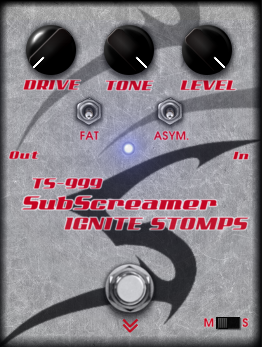


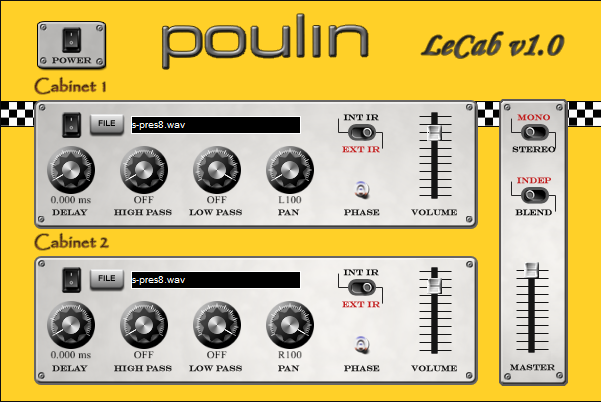
Posted by: Sensible Jones Jan 24 2013, 07:36 PM
First thing is roll the Tone back a bit on the TS 999, probably to between 12 and 2 o'clock. The other thing that's missing is some Reverb, which I'm sure there will be a Preset in the LeCab for.
Lastly, just drop the volume of the lead in the mix very slightly and it won't sound quite as 'harsh'.
Posted by: sammetal92 Jan 24 2013, 09:14 PM
Alright, I used some reverb with guitar rig, dropped NRR-1 and went for distortion in guitar rig, dropped LeCab.
How does this sound now?
https://soundcloud.com/sam-ryan-stormrage/guitar-rig-first-run
Posted by: osiris Jan 24 2013, 09:46 PM
Lastly, just drop the volume of the lead in the mix very slightly and it won't sound quite as 'harsh'.
I always choose delay over reverb for a lead tone. Reverb sometimes (rarely) on rhythm to glue it into the mix a bit.
Posted by: Sensible Jones Jan 24 2013, 09:55 PM
It's getting better Sam! Maybe drop the gain on which ever Distortion you're using in GR, on your sound clip you can hear that buzzing between the 2 riffs.
Another way to build a Tone is to start with everything turned low and turn one thing up at a time and hear what it does to your sound. Sometimes if you start with a lot of things and they're all turned up then they compound the problem of isolating the one thing you want to adjust!
![]()
A good point, I was just working with trying to get it to sit on that backing track better.
For creating a Lead Tone from scratch I'm with you on the choice of Delay over reverb.
Posted by: sammetal92 Jan 24 2013, 10:21 PM
Another way to build a Tone is to start with everything turned low and turn one thing up at a time and hear what it does to your sound. Sometimes if you start with a lot of things and they're all turned up then they compound the problem of isolating the one thing you want to adjust!
I'm using the simple green distortion thingy in GR (sorry I'm new to all this
And I have no idea what impulses do, in fact they made the quality low for me. Maybe its the wrong way to use them the way I'm using them, but I downloaded a package of impulses and there are a lot of them. I don't know which one to pick or how to use them
I know its gotta do with the placing of microphones in front of the amp and recording the response, but I just don't get how they work in a cabinet
I'll try building a new tone first thing tomorrow morning. Meanwhile, I'll try understanding how to use those impulses, any help you guys can provide is more than welcome
Posted by: Sinisa Cekic Jan 25 2013, 01:15 AM
Cab impulses are great if you now how to deal with it ![]() I have read somewhere a good article about it, yes, here it is..
I have read somewhere a good article about it, yes, here it is..
How to use impulses
What is an impulse response?
For the guys that don't give a fuck about explanations: what is an impulse response? A .wav file. This is all you need to know.
For the others: what is an impulse response?
An impulse response is the output of a system when the input is a Dirac impulse (for digital stuff). The Dirac impulse doesn't really exist, cause is teorically a signal with amplitude 1 and length 0 (that's why it doesn't exist).
So if you run a Dirac impulse in the input of your system, you'll get the impulse response on the output.
The impulse response contains the linear characteristics of your system (i.e. frequency response) and does not capture non-linear things (i.e. distortion/saturation).
This is just a rough/stupid/useless-for-musicians description, for more informations you can search on the net...
Basically impulse responses can be used to capture frequency response and reverb.
The cab impulses you'll find here are just impulse responses of cab + mic systems (remember also the they contains also the frequency response of the power amp and the mic preamp).
Impulse responses are REALLY accurate. An analog cab sim (like ADA, Palmer, etc.) will NEVER match the accuracy of an impulse response. In this case the digital world fucks the analog world right in the ass. Believe it or not.
POD, V-AMP, Amplitube 2 and Guitar Rig 2/3 cab sims are ALL impulse based. The problem is that the impulse responses used are a bit crappy, that's why I (and a lot of guys here) never use them...
Ok, how to use them?
If your amp-sim does not support an external impulses loader, you'll need a DAW (Cubase, Reaper, Sonar, etc...).
Load your ampsim and BYPASS THE CAB (this is IMPORTANT).
How to bypass the cab?
Guitar Rig: just CLOSE the cab (or matched cab) module. I mean CLOSE, not switch off! This is IMPORTANT. GR cab-sims even if switched off, do change the eq! So, you HAVE TO CLOSE IT WITH THE "X" BUTTON.
Amplitube 2: go into the cab section and activate the BYPASS switch you see in the upper right corner.
Wagner Sharp: you don't need to do anything. Wagner doesn't have a cab emulation.
Dirthead 0.6/0.8: switch off the "CABINET" button on the right of the interface.
BTE Juicy77: select "cabinet disengage" or something like that in the lower bar of the interface.
Simulanalog JCM900: you CAN'T bypass the cab... I know, that's bad...
Now, if you have bypassed the cab correctly, when you play a distorted preset you'll hear a total shitty sound, fizzy as hell, no bass, harsh... it's ok, you're hearing how an amp sounds like without a cab.
Now, after the amp-sim, you have to load a VST that allows you to import impulse responses for convolution.
I'll describe only 2 programs: Voxengo Boogex and KeFIR, cause they're FREE and with NO LATENCY.
Voxengo Boogex
Get it here: http://www.voxengo.com/product/boogex/
Boogex is an amp-sim, if you want to use it ONLY for cab simulation, you have to set all the parameters FLAT, or it will change your eq/sound.
So, open it and set, from the left: Lows Mids and Highs to 0db, Tone to 0%, Drive to 0db, Dynamics to 0%, Phase to 0%, Out as you want (it's the volume control), Dry Pre Cab and Dry Post Cab to "-inf" (knob all the way down).
The "Speaker Cabinet Impulse Response" button MUST be ON, obviously.
Then click on "file" and select your impulse (a .wav file).
An important thing about Boogex: this software features a built in LPF and HPF. They can't be totally bypassed. The best thing to do is to open them to the max. How? Click on the green point in the right area of the graphic section of the interface and move it all the way to the right, then click on the white point in the left area and move it all the way to the left. This will "open" the filters.
KeFIR
Get it here: http://habib.webhost.pl/vst_keFIR.php
KeFIR is a simple VST that allows your to load impulse responses.
Just click on "Load", select you impulse response (a .wav file) then set the "Mix" parameter to 100% (this is important) and set the length as you want (more length = more cpu consumption). Don't set it too short or you'll end up bypassing the impulse. Most impulse responses (like the GuitarHack's ones) have the tail cutted, so set the length to the max is useless. Just leave it as is when you load the impulse.
Set the "Gain" knob as you want.
Play... if you hear a normal tone, with no harshness/fizzyness, you're done.
I have issues with Boogex sometimes... I load it and I have no sound out of it... I don't know why... to solve the problem remove the track where you've loaded Boogex, create another track and reload it. Works for me.
Remember that you can use impulses with real preamps/pedals too.
Just connect the preamp/pedal output into your soundcard, load one of the programs above, load an impulse and play.
WARNING: DO NOT CONNECT THE POWER AMP OUTPUT OF YOUR HEAD TO YOUR SOUNDCARD! USE THE PREAMP OUTPUT ONLY, OR THE FX-SEND. IF YOU HAVE A TUBE POWER AMP, YOU HAVE TO CONNECT IT TO THE CABINET ANYWAY, OR YOU'LL DAMAGE THE TUBES AND THE TRANSFORMER ($$$).
http://www.guitarampmodeling.com/viewtopic.php?f=32&t=2452
Posted by: ConnorGilks Jan 25 2013, 04:41 AM
Maybe this will help you a bit, it's a guide I wrote on putting together some great guitar sounds using those free plugins you talked about:
http://www.connorgilks.com/apps/blog/show/18567655-record-distorted-guitar-for-free-at-home-using-ir-s-pc-or-mac-
Things to take note of are using a tube screamer in front (drive at 0, level at full can help make the amp more dynamic without adding much color or gain on top of what you already have), using a low pass and high pass, and using lower gain! I find that when recording the less gain you use the fatter your guitars will sound. And if you're going to be double-tracking your guitars they will still sound just as heavy and distorted as you require when they are put in the mix. Also, midrange helps your guitars cut through the mix and stand out a lot.
Lastly, try opening up an EQ plugin and create a boost (as much as you can boost) with a really narrow Q. Then slowly drag that peak through the frequency spectrum and see if you can hear any frequencies that are making your guitars sound very dull, then cut them out at that point. It's a technique that should be used selectively, but can be extremely helpful!!
Posted by: Todd Simpson Jan 25 2013, 07:48 AM
Your tone is improving!!! It really is a LOT about digging in to it and trying different things. There is a TON of trial and error involved. In can be frustrating/tedious, but it can also be fascinating/rewarding. View it like a puzzle of tone. I've been creating VST custom patches for several years and it's taken me that long to really be happy with the results. I"ve shared all of my presets in my person forum board. But don't be in a big rush to dive in to those yet and learning the basics in AMPLITUDE free is a GREAT way to understand the basics of modeling. Much of what you learn will transfer to other emulators like OVERLOUD TH1, TH2, AMPLITUDE METAL, etc. They are all different, but they share certain ideas. You are learning those idea right now. Keep at it and save your presets as you go!!!!
As an example, the solo that you commented on that I did for the BRIT METAL III collab was done entirely using VST software. IN that case, OVERLOUD TH1 which is the starter version of OVERLOUD. ![]()
Fore
Todd
And I have no idea what impulses do, in fact they made the quality low for me. Maybe its the wrong way to use them the way I'm using them, but I downloaded a package of impulses and there are a lot of them. I don't know which one to pick or how to use them
I know its gotta do with the placing of microphones in front of the amp and recording the response, but I just don't get how they work in a cabinet
I'll try building a new tone first thing tomorrow morning. Meanwhile, I'll try understanding how to use those impulses, any help you guys can provide is more than welcome
Posted by: sammetal92 Jan 25 2013, 08:21 AM
Thank you Mr Cekic, that cleared things up about impulses! ![]()
Thanks Connor, that's gonna help me a lot, and I commented on your blog, too ![]() I wonder why aren't any more people reading and commenting, its very useful information on there
I wonder why aren't any more people reading and commenting, its very useful information on there ![]()
Thank you Mr Simpson, I think patience can be an issue for me some times ![]() and I'm gonna try overloud next. And I'm saving the presets I think are GOOD enough
and I'm gonna try overloud next. And I'm saving the presets I think are GOOD enough ![]()
I'm thinking right now how to route all tracks and add some high and low contour to my guitar tracks (like in the third video in Mr Jones' reply on this thread ![]()
Thank you all so much for bearing with me being new to all this! ![]()
Also, I have an idea. I have a boss ds-1 distortion pedal, maybe I can use it for boosting the signal from my guitar to the PC? By turning the tone to the middle and distortion completely off?
EDIT: I've managed to achieve an alright tone but its pretty flat and is irritating for anyone's ears... I'd like to know if and how anything can be done to improve the overall quality of the tone? I'm using equalization for high pass and low pass too.
Setup is (Sorry my setup is not as it was written before) TS999 -> Nick Crow 8505 Lead -> Poulin LeCab (Loaded with GuitarHack original center impulse) -> X-cita (for High and low contour -> ReaEQ
https://soundcloud.com/sam-ryan-stormrage/soundtest-no-3-not-so-good
Posted by: Todd Simpson Jan 25 2013, 05:31 PM
Nicely done! I'd say start experimenting with all the modules and setting available in the version you have. Knob tweaking is the key to finding your tone. You can use your distortion as a boost pedal ![]() Just turn down the distortion and tone like you were saying. The more boost you have, the more noise you may notice and need more noise gate.
Just turn down the distortion and tone like you were saying. The more boost you have, the more noise you may notice and need more noise gate.
Todd
Thanks Connor, that's gonna help me a lot, and I commented on your blog, too
Thank you Mr Simpson, I think patience can be an issue for me some times
I'm thinking right now how to route all tracks and add some high and low contour to my guitar tracks (like in the third video in Mr Jones' reply on this thread
Thank you all so much for bearing with me being new to all this!
Also, I have an idea. I have a boss ds-1 distortion pedal, maybe I can use it for boosting the signal from my guitar to the PC? By turning the tone to the middle and distortion completely off?
EDIT: I've managed to achieve an alright tone but its pretty flat and is irritating for anyone's ears... I'd like to know if and how anything can be done to improve the overall quality of the tone? I'm using equalization for high pass and low pass too.
Setup is (Sorry my setup is not as it was written before) TS999 -> Nick Crow 8505 Lead -> Poulin LeCab (Loaded with GuitarHack original center impulse) -> X-cita (for High and low contour -> ReaEQ
https://soundcloud.com/sam-ryan-stormrage/soundtest-no-3-not-so-good
Posted by: sammetal92 Jan 25 2013, 06:51 PM
Guys I was experimenting and guess what! No wait... I'm gonna let you just listen to it! ![]() I've been experimenting!
I've been experimenting! ![]()
https://soundcloud.com/sam-ryan-stormrage/squeeky-alien-sound-thingy
Posted by: Gabriel Leopardi Jan 25 2013, 11:38 PM
https://soundcloud.com/sam-ryan-stormrage/squeeky-alien-sound-thingy
yeah! I heard this on in my Vchat and I loved it! It's cool to find you experimenting with weird tones. I think that your main lead tone still needs some work. For any reason it still sounds weak, like a "line" sound, you still need to work to make it sound more real. I don't think that adding the Boss pedal before your computer is a good idea. I think that you still need to experiment with the different cabs, mics and emulated pedals. One thing that usually works for me is to set the amp with a low drive and adding an emulation of the tube screamer to have gain and sustain. Have you tried it?
Posted by: ConnorGilks Jan 26 2013, 02:48 AM
Thanks man! I appreciate that a lot.
Can you post pictures of your settings on the amp, OD and EQ plugins you're using? I may be able to help more that way.
Posted by: jstcrsn Jan 26 2013, 02:58 AM
https://soundcloud.com/sam-ryan-stormrage/squeeky-alien-sound-thingy
what pick up and guitar do you have ?
Posted by: sammetal92 Jan 26 2013, 06:47 AM
I have tried putting the tube screamer in front of the amp and then using an impulse loader. Getting a lead tone is really hard, rhythm is a bit easier compared to that.
I think it has something to do with equalization maybe? I don't know for sure.
Can you post pictures of your settings on the amp, OD and EQ plugins you're using? I may be able to help more that way.
Yeah, I'll do that when I get home, I don't have them on my laptop. I need to learn more about Equalization and compression
I have a really old non branded guitar, its a custom guitar
EDIT: Here we go, another tone
My setup (screenshots below): TSE808 -> Poulin SoloC head v2 -> GGate Noise Gate -> Poulin LeCab (loaded with Catharsis Fredman Impulse) -> ReaEQ (For performing high pass low pass equalization) -> (After quad-tracking guitar tracks and routing them to one FX channel track) X-Cita with some Equalization
My soundtest:
https://soundcloud.com/sam-ryan-stormrage/iron-maiden-soundtest
Screenshots:
TS808:
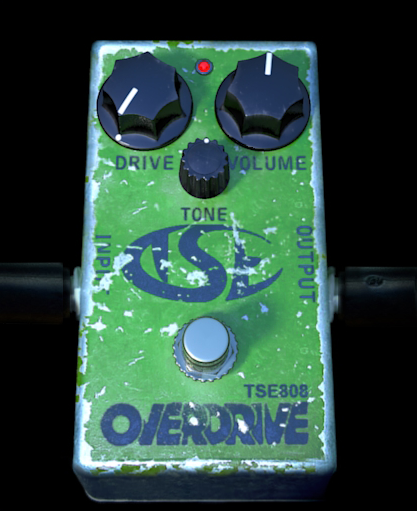
SoloC Head:
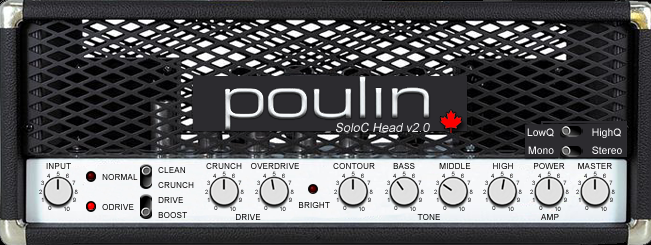
GGate:

LeCab:
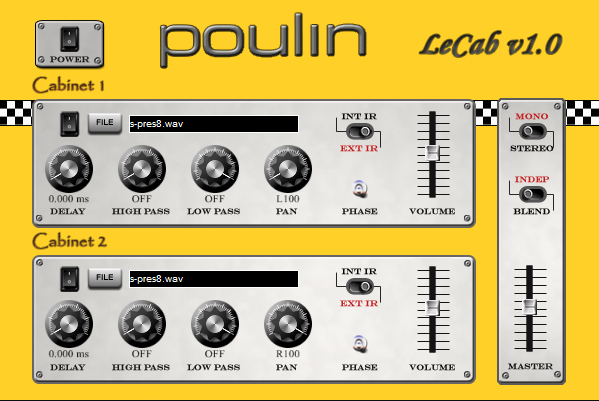
High Shelf:
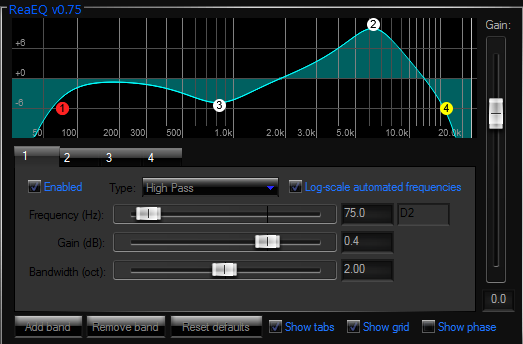
Low Shelf:
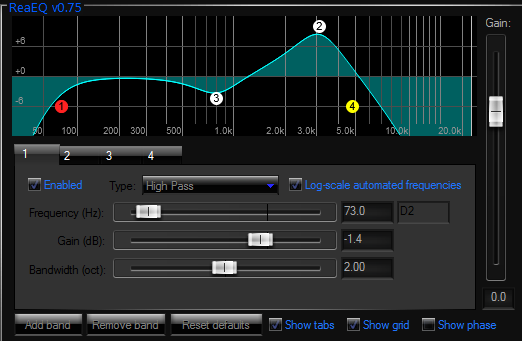
X-Cita
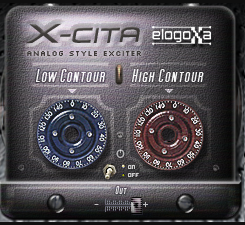
Final Equalization:
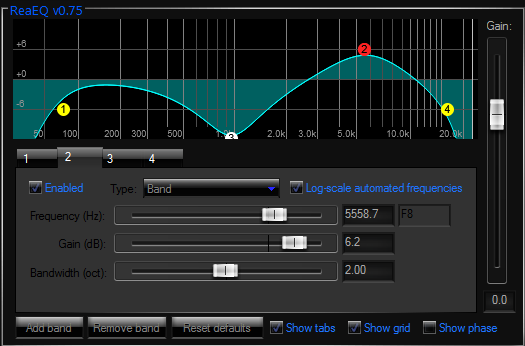
Posted by: ConnorGilks Jan 27 2013, 08:56 AM
Thanks man, this is helping a lot.
First thing I would do is crank up the mids on your amp plugin to at least 7 or 8. That's what you will need in order for your guitars to cut through in a mix.
Secondly, take out the Xcita plugin for now. It's not necessary to get a great tone, and in my experience you need to start small, get a great tone, then slowly add in things rather than throwing a bunch of plugins on at once and trying to get them all to work together.
Next, turn the volume on the tube screamer plugin to FULL. If it's too loud control your volume elsewhere (your track volume, input level etc). This will give you more dynamics and clarity.
Now, for your EQ plugins you should be using ONE EQ plugin and ONLY ONE EQ plugin on your guitar tracks for now. You should open ONE instance of ReaEQ and it should look more like this:
Start there, simple and straight forward. The way you've EQ'd things is not effective at all. Large cuts and boosts are NOT what you should be doing, especially if you're not very well educated with EQ and recording basics. Some engineers still prefer to do larger cuts and boosts, but these are people who are very well educated and chose this method over the more conventional method of isolating smaller areas to EQ.
Another tip is if you find that there's a frequency you don't like but can't put your finger on it, make a really small Q (area that the EQ point will effect) and boost it as high as you can. Slowly sweep through the whole frequency range until you find the frequency you don't like, then cut it out. You would think that if your tone is just "meh" that a small modification might not do much, but it can do an incredible amount. A small cut like that can bring clarity to muddy guitars, widen up narrow sounding instruments, even fatten up thin sounding instruments.
Lastly, I would pick an impulse that is NOT in the center of the speaker. I almost never see people record with the mic on the dead center of the speaker. Try an impulse that's On Axis, about half way between the cone and the edge of the speaker. Dead center will give you a heck of a lot of harshness. Here's a general reference guide:
Now, you can pretty much get any tone you want with an impulse on a V30 speaker with a 57 half way between the cone and edge of the speaker on axis. The rest can be done with amp and EQ settings really. You'd be surprised how much flexibility you have when you know a lot about EQing and mixing distorted guitars! ![]()
Anyways, hope that helps!
Posted by: Todd Simpson Jan 28 2013, 04:41 AM
Some fine tips and some great progress on your tone!!! Keep experimenting and keep the samples coming!
Todd
First thing I would do is crank up the mids on your amp plugin to at least 7 or 8. That's what you will need in order for your guitars to cut through in a mix.
Secondly, take out the Xcita plugin for now. It's not necessary to get a great tone, and in my experience you need to start small, get a great tone, then slowly add in things rather than throwing a bunch of plugins on at once and trying to get them all to work together.
Next, turn the volume on the tube screamer plugin to FULL. If it's too loud control your volume elsewhere (your track volume, input level etc). This will give you more dynamics and clarity.
Now, for your EQ plugins you should be using ONE EQ plugin and ONLY ONE EQ plugin on your guitar tracks for now. You should open ONE instance of ReaEQ and it should look more like this:

Start there, simple and straight forward. The way you've EQ'd things is not effective at all. Large cuts and boosts are NOT what you should be doing, especially if you're not very well educated with EQ and recording basics. Some engineers still prefer to do larger cuts and boosts, but these are people who are very well educated and chose this method over the more conventional method of isolating smaller areas to EQ.
Another tip is if you find that there's a frequency you don't like but can't put your finger on it, make a really small Q (area that the EQ point will effect) and boost it as high as you can. Slowly sweep through the whole frequency range until you find the frequency you don't like, then cut it out. You would think that if your tone is just "meh" that a small modification might not do much, but it can do an incredible amount. A small cut like that can bring clarity to muddy guitars, widen up narrow sounding instruments, even fatten up thin sounding instruments.
Lastly, I would pick an impulse that is NOT in the center of the speaker. I almost never see people record with the mic on the dead center of the speaker. Try an impulse that's On Axis, about half way between the cone and the edge of the speaker. Dead center will give you a heck of a lot of harshness. Here's a general reference guide:

Now, you can pretty much get any tone you want with an impulse on a V30 speaker with a 57 half way between the cone and edge of the speaker on axis. The rest can be done with amp and EQ settings really. You'd be surprised how much flexibility you have when you know a lot about EQing and mixing distorted guitars!
Anyways, hope that helps!
Posted by: sammetal92 Jan 28 2013, 06:26 AM
Thank you Connor and Tod, I'll update you guys with a sample ASAP ![]()
Posted by: sammetal92 Jan 28 2013, 07:45 PM
I've experimented a little, and got a good lead tone with Connor's tips ![]() I noticed that I liked the sound of the mic at the very edge of the cone and nowhere else, polishes the tone a lot without making it harsh.
I noticed that I liked the sound of the mic at the very edge of the cone and nowhere else, polishes the tone a lot without making it harsh.
Check it out! ![]()
https://soundcloud.com/sam-ryan-stormrage/neoclassical
Posted by: ConnorGilks Jan 29 2013, 06:03 AM
Check it out!
https://soundcloud.com/sam-ryan-stormrage/neoclassical
Sounds great buddy! Keep it up!!
Another tip I wanted to throw in is to use an impulse closer to the middle of the speaker, as I suggested before, and then take your Low Pass filter (Remember, Low Pass mean THE LOWS PASS THROUGH, so we're really talking about the EQ that affects the highs) and pull it down a bit more to cut out more of the high end. You'll find a sweet spot where the harshness is gone, and it's really polished, but by using an impulse a bit further from the edge you'll get more "life" in the midrange and the lows.
Posted by: Gabriel Leopardi Jan 29 2013, 02:26 PM
Check it out!
https://soundcloud.com/sam-ryan-stormrage/neoclassical
Wou Sam! You tone is improving everyday!! and let me say that Connor's posts are brilliant. Thanks for sharing all that info!
Have you ever used a multi-band compressor for electric guitar?
Posted by: sammetal92 Jan 29 2013, 03:26 PM
Have you ever used a multi-band compressor for electric guitar?
Me? Nah, I want to learn how compressors work so I can use them but I think compressors don't have anything to do with metal guitar (especially extreme metal genres, which I love) cause they turn the volume down. I don't know though
Posted by: ConnorGilks Jan 29 2013, 11:56 PM
Compressors turn down the volume because that's their job, is to take the loud parts and make them quieter, and take the quiet parts and make them louder. When you use a compressor you need to compensate by raising the volume level again. It's all part of the process. They're great for every genre to make something sit better in the mix (more consistent volume throughout the whole song) and to make something pump a bit more as well (the attack is loud and uncompressed, then the compression kicks in after the initial attack to smooth it out, but still keeping it dynamic).
Gabriel: I appreciate the kind words man! I am no master myself though, my mixes are quite basic... but my band's EP is sounding excellent so far! My best production yet! It's all about learning and moving forward!
Multi-band compressors are something I haven't messed with extensively... I do use a multi-band compressor if I feel there's some bass frequencies clashing and building up, so that instead of using an EQ to remove the build up of bass, I try to control it with a multi-band compressor.
Posted by: tonymiro Jan 30 2013, 11:23 AM
Nicely put - in brief a compressor is normally used to suppress dynamic range and soetimes to limit the peak output of a track. They can however also be used artisitcally on an instrument or in a mix to, for instance, wave form shape, groove and so on.
It's also worth remembering that every make/model of compressor has its own sound. A VCA comp is very different to an optical or a vari-mu and different VCAs
(for instance) will all sound different. That's one reason why a pro mixing studio will have a number of different compressors in their racks. Often the best way of learning how to use a comp is to take one which only has very basic controls and play with it to see what it does and what the controls do.
Be careful with multi/split bands as they can be a quick way to butcher a mix. At mixing you have the stems/tracks and you are almost always better of using a broadband compressor, with or without sidechaining. A lot of people think us mastering engineers use MBCs routinely on the main mix. Most of us hwever use them only very occassionally and for very specific reasons and with a great deal of care. I think last year I used ours less than 5% of the times I used any of our broadband mastering compressors.
Posted by: osiris Jan 30 2013, 12:34 PM
I suck at compressors but I posted a beginner's guide on my blog: http://www.osirisguitar.com/how-to-use-a-compressor-with-great-power-comes/
Posted by: Gabriel Leopardi Jan 30 2013, 01:58 PM
It's also worth remembering that every make/model of compressor has its own sound. A VCA comp is very different to an optical or a vari-mu and different VCAs
(for instance) will all sound different. That's one reason why a pro mixing studio will have a number of different compressors in their racks. Often the best way of learning how to use a comp is to take one which only has very basic controls and play with it to see what it does and what the controls do.
Be careful with multi/split bands as they can be a quick way to butcher a mix. At mixing you have the stems/tracks and you are almost always better of using a broadband compressor, with or without sidechaining. A lot of people think us mastering engineers use MBCs routinely on the main mix. Most of us hwever use them only very occassionally and for very specific reasons and with a great deal of care. I think last year I used ours less than 5% of the times I used any of our broadband mastering compressors.
Tony is here!
Posted by: ConnorGilks Jan 31 2013, 12:41 AM
It's also worth remembering that every make/model of compressor has its own sound. A VCA comp is very different to an optical or a vari-mu and different VCAs
(for instance) will all sound different. That's one reason why a pro mixing studio will have a number of different compressors in their racks. Often the best way of learning how to use a comp is to take one which only has very basic controls and play with it to see what it does and what the controls do.
Be careful with multi/split bands as they can be a quick way to butcher a mix. At mixing you have the stems/tracks and you are almost always better of using a broadband compressor, with or without sidechaining. A lot of people think us mastering engineers use MBCs routinely on the main mix. Most of us hwever use them only very occassionally and for very specific reasons and with a great deal of care. I think last year I used ours less than 5% of the times I used any of our broadband mastering compressors.
Great stuff!
I should also add that because sometimes it's hard to "hear" what a compressor is doing, while messing around with the controls keep an eye on the output meter (not to be confused the the input meter in your DAW, unless your compressor is before your computer in your signal chain... anyways
Posted by: Todd Simpson Jan 31 2013, 05:08 AM
yet more fine tips from Connor! And good idea to explain "LOW PASS". We often used jargon and don't realize. Likewise HIGHPASS lets the HIGHS PASS THROUGH. If you don't hear the "HARSHNESS" that Connor is talking about, try to listen on as many things as you can. E.G car stereo, home stereo, headphones, ear buds, etc. Just to get an idea of how the sound will translate on different systems and maybe to hear things you are not hearing in your primary mix location.
What are you mixing on BTW? Headphones? Monitors? All of which will have it's own impact ![]()
The good news is your getting better at this stuff every single day!
Too
Another tip I wanted to throw in is to use an impulse closer to the middle of the speaker, as I suggested before, and then take your Low Pass filter (Remember, Low Pass mean THE LOWS PASS THROUGH, so we're really talking about the EQ that affects the highs) and pull it down a bit more to cut out more of the high end. You'll find a sweet spot where the harshness is gone, and it's really polished, but by using an impulse a bit further from the edge you'll get more "life" in the midrange and the lows.
EGAD!!!!! Had to respond on this, IMHO COMPRESSOR ARE CRUCIAL TO METAL GUITAR!!!! They are the secret sauce used to even out palm mute chugs and even to allow lighter strikes during lead passages. All of my presets for emulators that I share here on GMC have at least 1 compressor. Same for my multi effect pedal patches in the hardware world. I know it seems like just more complication but it's really worth it. Connor is spot on here.
Todd
Posted by: sammetal92 Jan 31 2013, 07:41 AM
What are you mixing on BTW? Headphones? Monitors? All of which will have it's own impact
The good news is your getting better at this stuff every single day!
I'll do that
Todd
Didn't know that
Posted by: tonymiro Jan 31 2013, 11:28 AM
I do use a MBC/splitband very occassionally in mastering Gab. Just not very often. I think that I used ours probably in 10 sessions last year compared with using our main broadband comp several 100 times. I think that there's a bit of a myth that an MBC is a 'secret weapon' used by mastering engineers all the time. I've certainly seen a lot of software vst manufacturers say this. In my experience it's just not true as the majority of us tend to use (hgh quality) broadband compressors far, far more regularly. Ultimately though there isn't a routine set up that you always use as you choose what is most appropriate for the session. Having said that most sessions benefit from MP EQ and broadband compression. That's the reason why we keep several mastering eqs and compressors in our main mastering router chains and why they sit in the main racks whilst the MBC and other stuff is only brought in when needed.
I should also add that because sometimes it's hard to "hear" what a compressor is doing, .... so you know what you're listening for.
Very true Conner. One of the things I suggest is that peope play with the comp on quite extreme ratio and threshold settings on different material and instruments so that they get to hear more clearly what that is doing. Once they get used to that then do the same with attack and release etc. IF you don't know what a comp 'sounds' like then you might not notice what subtle adjustments do. You have to get used to hearing what the comp does.
In mastering most of the use of a comp by the way is subtle (fractional ratios etc), a lot of very good mixing comps are too heavy handed for what we do and mix monitors tend to lack sufficient detail for us to really be able to pull out sufficient detail to do the adjustments. One of the on-going issues with the use of MBCs in 'bedroom masters' is that they are used with too heavy a hand only to get more level.
Posted by: ConnorGilks Feb 6 2013, 03:27 AM
Any progress been made here? I found doing a broad cut between 200Hz-500Hz gave it a lot more clarity and cleaned up the tone, and another between 600Hz-800Hz helped liven up the tone and make it sound less flat, really gave it some air.
Posted by: sammetal92 Feb 6 2013, 03:46 PM
Yeah I'm still experimenting, though not as much, sorry my university takes most of my time these days
Posted by: Jonas Tamas Feb 6 2013, 04:22 PM
I recommend using a BBE Sonic Maximizer plugin. It is basically a special compressor/limiter plugin, but it shapes the sound like magic. It is able to create a great sound from a mediocre input.
You can listen to the tone possibilites here, this is one of my improvisations using BBE Sonic Maximizer:
http://soundcloud.com/jonas-tamas/melodic-guitar-improvisation
Posted by: ConnorGilks Feb 6 2013, 10:24 PM
Didn't mean to bug you, just liked seeing your progress and how quickly it was coming along!
Posted by: sammetal92 Feb 7 2013, 08:56 AM
You can listen to the tone possibilites here, this is one of my improvisations using BBE Sonic Maximizer:
http://soundcloud.com/jonas-tamas/melodic-guitar-improvisation
No noo you didn't bug me at all, sorry if I said it like that, university's bugging me
Posted by: Jonas Tamas Feb 7 2013, 09:01 AM
You're welcome. If you need my tips and/or settings regarding BBE, just let me know.
Posted by: sammetal92 Feb 7 2013, 09:08 AM
I'll bug you loads, thanks
Posted by: tonymiro Feb 7 2013, 02:32 PM
You can listen to the tone possibilites here, this is one of my improvisations using BBE Sonic Maximizer:
http://soundcloud.com/jonas-tamas/melodic-guitar-improvisation
Actually it's more of a distortion device that adds higher frequencies to the recording. They were pretty popular back in the 80s but it's the sort of device that you need to be very careful with. It can work on some instruments, electric guitar and bass for instance, and in some contexts but I'd be very cautious in using all the time as it's not always going to help and can easily make things worse. If you do use one then I's suggest that you only have it on individual tracks and that you keep it off the 2 bus.
Posted by: Jonas Tamas Feb 7 2013, 02:47 PM
Thanks for the detailed info Tony! Yes, I use BBE only on my solo tracks, and add just a little bit of modification to the track. I really like how it enlivens the lead tone.
Posted by: sammetal92 Feb 7 2013, 02:57 PM
I'll keep that in mind
EDIT: Oh, I didn't see that before O_O its for $149 ._. Don't have that kind of money at the moment and they don't offer lite/trial/demo versions either, any free alternatives?
Posted by: ItSME3 Feb 7 2013, 04:07 PM
You can listen to the tone possibilites here, this is one of my improvisations using BBE Sonic Maximizer:
http://soundcloud.com/jonas-tamas/melodic-guitar-improvisation
great great playing and tone. Whats the ampsound, cab. models etc ? !!!!
Posted by: sammetal92 Feb 13 2013, 12:44 PM
My tone is getting better I think, but I have to frequently change the combination of VSTs I use ![]() But it doesn't bother me
But it doesn't bother me
Check it out:
https://soundcloud.com/sam-ryan-stormrage/composition-harmonic-minor
Posted by: Jonas Tamas Feb 13 2013, 02:42 PM
Hi, thanks a lot! This solo tone was made with a Boss GT-3 effects processor, Mesa Boogie amp modeling (it is called "BG Lead" in GT-3), and I have added a bit of overdrive and compression. The signal then went straight to the line-in of the PC, where I have added the BBE plugin.
Check it out:
https://soundcloud.com/sam-ryan-stormrage/composition-harmonic-minor
Hi Sam, these tones are in fact really good now. The rhythm tone has the 'bite', and the lead tone was good as weel. Did you changed settings around 0:47, or did you just turn the lead volume up? Apart from being louder, I'm also hearing a lot more presence in the lead tone after 0:47, so I'd vote for this setting.
From the technical point of view, try to experiment with wider and more articulated vibratos, when you play longer notes. I hear that you use a vibrato, but they could be a bit wider, for maximum effect. Also it is a good way of embellishing the long notes to slide down at the end of the note. Then you can start the next note with a quick slide-up. These slides give a new character to the long notes, they not just start and cease, but they "born" and "die", which brings out your passion of playing a lot more.
Posted by: sammetal92 Feb 13 2013, 02:52 PM
No, I actually tried to keep the volume down during that part
Yeah many people have told me to improve my vibrato, so I'm working on that, I have some open strings in the lead parts of this one, so you don't hear a vibrato at all in some parts. And I'll keep that in mind about starting and ending notes with slides, thanks for the tip
Posted by: Jonas Tamas Feb 13 2013, 03:07 PM
Yeah many people have told me to improve my vibrato, so I'm working on that, I have some open strings in the lead parts of this one, so you don't hear a vibrato at all in some parts. And I'll keep that in mind about starting and ending notes with slides, thanks for the tip
You're welcome! You are on a good way, because the melody of your recording (the one which is harmonized in octaves) keeps repeating in my head now, and it is always a good sign!
Posted by: sammetal92 Feb 13 2013, 04:18 PM
Thank you Jonas! Achieving a catchy melody is hard for me
Posted by: Jonas Tamas Feb 13 2013, 10:35 PM
It's my pleasure, it was truly the case!
Powered by Invision Power Board (http://www.invisionboard.com)
© Invision Power Services (http://www.invisionpower.com)
